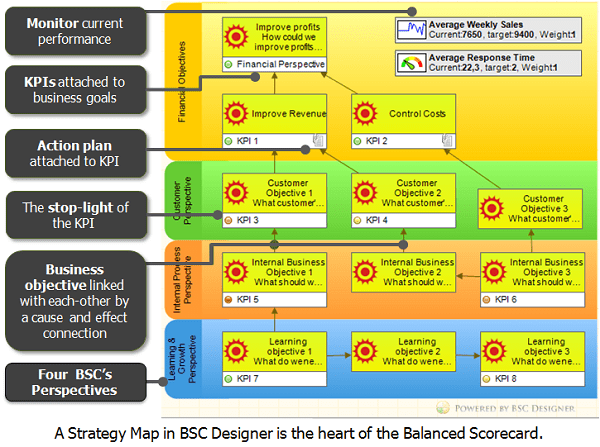An introduction to using the Balanced Scorecard for performance management in Digital Marketing
The Balanced Scorecard is a well known performance management tool. It suggests following a cause-and-effect logic to build a tree of business objectives moving from a financial perspective down to customers, process and education and growth, and then enriching the entire scheme with KPIs and action plans.
Who said that it is for international companies only? What about an Internet company that wants to manage its performance? I believe that the BSC framework will be very useful to focus strategic efforts on what matters.
Let's have a closer look at the marketing strategy of a business on the Internet. These will be some general thoughts that need to be adapted to the vision and mission of a specific company. So if you decide to follow these ideas then you must take them as a starting point for your own research and planning efforts.
Building a strategy map
Today's online marketing is about creating and promoting engaging content while obtaining backlinks and being good in the eyes of Google remains important. Let's see how these principles might fit into a digital strategy. Our software for a Balanced Scorecard management helps automate the process of strategy design and review.

Source: BSC Strategy map
- On the 'Finance' level our goal is to increase revenue, which obviously can be achieved by increasing profits and decreasing costs. What can we do to increase profits?
- What can we offer to our customers to increase profits? Here we have our objectives for a 'Customers' perspective. We need to attract more visitors, improve visitor to lead conversion and/or improve lead to sale conversion. I'll leave conversion issues for your own research and I'll focus on attracting more visitors, which is the most common problem.
- What should we do inside our business to get more traffic? Let's check what our goals on the 'Processes' level are. What should a website do to attract more visitors? It needs engaging content that will make people stop and read it, like a webpage in Facebook; you must share it with friends, and post a backlink in their blog. Another issue is that engaging content alone won't change a situation if no one knows about it, so we need to invest efforts in promoting this content. For example, that can be done by submission to social networks or by doing guest posts.
- Finally, the 'Learning and growth' perspective. Do you have an idea about what engaging content for your focus group is and how you can create it? Do you know how to choose the right websites for guest posts? If the answer is no, then these questions are objectives for the research.
Here we have our cause-and-effect connected objectives:
- improving profit,
- improving revenue,
- attracting more visitors to a website,
- creating engaging content, submitting to social networks, doing guest posts,
- and learning and testing the best practices for objectives mentioned above.Magic starts happening, as with this approach a big picture of what's going on can be seen and it is easier to explain 'why' and 'how' things work to your team.
Adding KPIs
Now we need to add to a strategy map, KPIs that will tell us if you are on the right track or not.
What about engaging content? How do we know that we finally created some?
- We can compare the number of likes and comments that a content receives to an average number of likes that our old content got (the process called benchmarking in a business world); more likes is a sign that the content is more engaging.
- With Google Analytics we can check the time a visitor spends on a website, the more engaging content is, the longer a visitor will stay.
Let's try to come up with some KPIs for a guest post. What are the success factors of a good guest post? For a guest post as a website owner, I would expect some direct referrals to my website and some SEO effect that depends on current ratings of the target blog.
Mention KPIs that describe the process, not the results. So we need to add result-oriented KPIs.
Action plan
Once KPIs and business objectives are aligned, it is a good time to start acting.
- Action plan. For example, we can plan to do at least 10 qualified guest posts in the next 3 months. In 3 months, we will use KPIs to see if these guest posts helped to attract more visitors and/or increase average monthly visitors.
It might be hard to isolate an effect of the guest posts, especially if you are running more marketing actions. That's why I suggest focusing on some tangible result (like getting some direct traffic) since measuring the effect of SEO might not be accurate.
[Editor's note for Expert members: we have further advice on the best KPIs to use for creating a Balanced Scorecard in our Guide to Getting Results from Digital Marketing - p29 currently].

Thanks to Aleksey Savkin for sharing his opinions and thoughts in this blog post.
Aleksey Savkin is a founder of AKS-Labs, vendor of BSC Designer software and tools for software engineers. His areas of expertise are remote team management,
Balanced Scorecard Software, KPIs, business performance management, general info-business development and marketing. Aleksey is the author of a number of articles and books on Balanced Scorecard. He runs Balanced Scorecard seminars in the Moscow Business School (MBS). You can connect with him on
LinkedIn.




 Thanks to Aleksey Savkin for sharing his opinions and thoughts in this blog post.
Thanks to Aleksey Savkin for sharing his opinions and thoughts in this blog post. 



